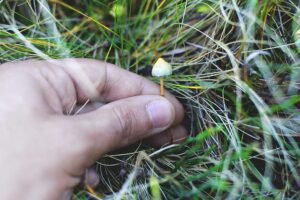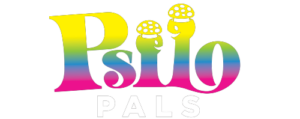Notable Elements
Introduction to Magic Mushrooms: They are fungi known for their mind-altering effects, primarily attributed to active compounds psilocybin and psilocin. Found under the genus Psilocybe, they are scattered in various global locations.
The Psychoactive Compounds: Magic mushrooms owe their hallucinogenic properties to compounds like psilocybin, psilocin, baeocystin, and norbaeocystin. These chemicals interact with serotonin receptors in the brain, leading to sensory distortions and altered reality perceptions.
History and Cultural Value: Magic mushrooms have deep roots in ancient Mesoamerican cultures and religious rituals. They’ve gained prominence in popular culture and scientific research in modern times.
About Psilocybin and Psilocin: These are the most studied compounds in magic mushrooms. Psilocybin transforms into psilocin upon ingestion, which then binds to the serotonin receptors to induce psychedelic experiences.
Chemical Structures: Psilocybin and psilocin are part of the tryptamine family, similar to the neurotransmitter serotonin. Their structures enable them to interact seamlessly with the brain’s serotonin receptors.
The Brain Interaction: When consumed, magic mushrooms’ active compounds influence neuronal activity, especially with the 5-HT2A serotonin receptor subtype, leading to psychedelic experiences.
Potential Therapeutic Uses: Emerging research highlights psilocybin’s potential in treating mental health disorders like anxiety, depression, and addiction by facilitating a brain “reset.”
Possible Side Effects: While magic mushrooms can lead to euphoria and profound insights, they can also cause nausea, altered perception, mood changes, and hallucinations.
Advocating Responsible Use: Given their potent effects, it’s crucial to consume magic mushrooms responsibly, ideally under expert guidance, to avoid negative experiences.
Legal Implications: Magic mushrooms’ legal status varies worldwide. While they’re classified as a Schedule I drug in the U.S., other countries may have more lenient regulations.
Introduction
Let us start our captivating journey into the world of magic mushrooms. These unusual fungi, also known as shrooms, have been a subject of interest for people across various cultures owing to their mind-altering effects. They belong to the genus Psilocybin, found in different parts of the world.
Magic mushrooms could easily be mistaken for any ordinary mushroom of nature walks. However, what separates them from the rest are their active, psychoactive ingredients – psilocybin and psilocin. When ingested, these compounds trigger hallucinogenic effects, often characterized by sensory distortions, altered perception of reality, and sometimes profound spiritual experiences.
- They are found in varied environmental conditions, usually favoring moist and humid surroundings.
- Over 180 species of magic mushrooms are known today.
- Different species may contain varying concentrations of psilocybin and psilocin, affecting their potency.
What are Magic Mushrooms?
Magic mushrooms, more scientifically known as psilocybin mushrooms, are a group of fungi that contain naturally occurring psychoactive and hallucinogenic compounds, primarily psilocybin and psilocin.
Magic mushrooms fall under the genera Psilocybe, with over 180 known species, although other genera, such as Gymnopilus, Panaeolus, and Copelandia, also contain psilocybin. These mushrooms are identified by their long, slender stems topped with caps that may be conical or flat and often bear a dark spore print. Beyond their physical characteristics— magic mushrooms have a much richer story to tell in terms of history and cultural significance.
Historical and Cultural Significance
Historical texts, visuals, and artifacts suggest that magic mushrooms have been used in religious rituals and healing ceremonies for thousands of years. They played a significant role in early Mesoamerican cultures, where they were known as teonanácatl or flesh of the gods.
In modern times, these hallucinogenic fungi have entered popular culture, featuring in music, films, and literature. Despite their controversial legal status in many countries, the scientific community is witnessing a renewed interest in their potential therapeutic properties. From spirituality to science, the magic mushroom continues to captivate our curiosity and invite exploration.
Chemical Composition of Magic Mushrooms
Shrooms belong to the genus Psilocybe. This genus comprises over 200 species rich in active compounds capable of inducing varied psychedelic experiences.
Let us begin by identifying the key components of these mysterious fungal organisms. The main psychoactive compounds present in magic mushrooms are:
• Psilocybin
• Psilocin
• Baeocystin
• Norbaeocystin
These compelling chemicals are responsible for the hallucinogenic effects associated with magic mushrooms. They function by interacting with the serotonin receptors in the brain, triggering a range of mind-altering experiences, from mild sensory distortions to hallucinations, profound insights, and even mystical experiences.
About Psilocybin and Psilocin
Among these, psilocybin and psilocin are the most prevalent and well-studied. Psilocybin is a naturally occurring psychedelic compound— however, upon ingestion, it gets converted into psilocin within the human body. This conversion is critical as its psilocin binds the serotonin receptors in our brains, thereby inducing the psychedelic effects.
Psilocybin: Structure and Synthesis
Psilocybin is a naturally occurring psychedelic compound consisting of 4-phosphoryloxy-N and N-dimethyltryptamine. This structure places it in the family of tryptamine compounds similar to serotonin, a chemical our brains naturally produce. The characteristics of psilocybin structure include:
- A double-ring system— as an indole structure, is found in many biologically active compounds.
- A phosphoryloxy (-PO4)— function is attached at the 4-position of the indole ring.
- Dimethylamino (N(C— group at the end of a 2-carbon side chain
Psilocybin naturally occurs in over 200 species of magic mushrooms. The fungal genera Psilocybe, Panaeolus, and Gymnopilus are the common sources. The synthesis process within these mushrooms is an enzymatic reaction, converting tryptophan into psilocybin.
On the other hand, scientists can also produce psilocybin synthetically in the lab. In 1958, Dr. Albert Hofmann, the same chemist who first synthesized LSD, was the first to synthesize psilocybin. He did this to conduct research in a more controlled environment. Although the production process is more complex and costly, synthetic psilocybin has been instrumental in forging modern psychedelics research.
Psilocin: Structure and synthesis
The molecular skeleton of psilocin is a tryptamine derivative. Tryptamines are a group of compounds that play a pivotal role in different biological systems, often related to neurological functioning.
Psilocin closely resembles serotonin, a vital neurotransmitter in our brain. Remarkably, its structure consists of an indole ring attached to an ethylamine chain. This shape subtly mimics serotonin, allowing it to interface flawlessly with serotonin receptors in the brain. Because our neurons think they are interacting with serotonin, actually interacting with psilocin, their behavior changes in strange and often visually dramatic ways.
Conversion of psilocybin to psilocin in the body
When we ingest magic mushrooms, the magic begins. Your body does not directly process psilocybin. Instead, it is converted into psilocin by enzymes in the liver. From there, it makes its way up to your brain.
The process of converting psilocybin to psilocin is known as dephosphorylation. Certain enzymes in the liver remove a phosphate group from the psilocybin molecule to leave psilocin.
This conversion is essential, as psilocin is the active form that can interact with receptors in the brain.
How do they interact with the human brain?
When consumed, psilocybin is quickly metabolized into psilocin by the human body, which readily crosses the blood-brain barrier. Once inside the brain, psilocin influences neuronal activity by binding to serotonin receptors, particularly the 5-HT2A subtype. Although science has to elucidate the process— this interaction is believed to be responsible for the onset of the psychedelic experiences.
Also Read : Magic Mushrooms For Mental Health
Neurotransmitter involvement
Serotonin, a neurotransmitter, plays an integral part in this complicated chemical dance. Serotonin is a neurotransmitter that regulates our moods, feelings, and thoughts. It also aids in-memory processing and learning. Psilocin tricks the neurons and unusually excites them by imitating serotonin, which might cause mood and perceptual shifts.
Hallucinogenic and psychedelic experiences
Following ingestion of magic mushrooms, individuals often report experiencing deeply profound and surreal phenomena, such as:

- Altered sense of time and space.
- Vivid visual and auditory hallucinations.
- Spiritual experiences and feelings of universal connectivity.
- Intense euphoria and peace.
- Deep introspective and philosophical thoughts.
These experiences are highly mutable, influenced by factors, dosage, set and setting, and individual predispositions. Although these experiences are usually temporary, they can occasionally lead to profound and lasting changes in perspective and personality. Indeed, it has piqued the interest of researchers and psychonauts alike.
Research on the Benefits of Psilocybin and Psilocin
Reports from various scientific studies emphasize that the principal active compounds, psilocybin, and psilocin, have marked effects on the human brain harnessed for medical purposes. These compounds specifically interact with the serotonin receptors in our brain, leading to a range of psychological effects.
Psilocybin, in particular, has been shown to foster feelings of euphoria and spiritual interconnectedness and could be beneficial in therapy sessions and spiritual practices.
Psilocin impacts our sense of time, thought processes, and perception.
Treatment of Anxiety, Depression, and Addiction
Emerging research suggests that these psychoactive compounds could also play a significant role in treating mental health disorders.
Studies have shown psilocybin is potent to decrease anxiety and depression levels while assisting in addiction therapy. They kickstart a reset in the brain, providing patients with a fresh start and a new outlook on life. Further research needs to fully understand how these compounds may be utilized in a safe and controlled manner.

Potential Adverse Effects
The main active compounds in magic mushrooms— psilocybin and psilocin are potent hallucinogens. As such, they can prompt a range of physical and psychological effects worth noting:
﹣ Physically, they may cause nausea, vomiting, and changes in heart rate, blood pressure, and temperature.
﹣ Psychologically, they can trigger altered perception, mood changes, and intense hallucinations.
However, these effects vary significantly from person to person as they depend on factors such as tolerance, dosage, mushroom species, and mental state.
Importance of Responsible Use
The varied impacts underline the need for responsible use of magic mushrooms. Consume these substances under the guidance of an experienced individual or in a regulated environment. Misuse can lead to frightening experiences and bad trips.
Possession, cultivation, and distribution of magic mushrooms are illegal in many parts of the world. Responsible use involves respecting the power of these psychoactive compounds and adhering to local laws and regulations.
Legal Status and Regulations
Understanding the legality of magic mushrooms is crucial, given their psychoactive nature. The laws surrounding these unique fungi vary worldwide, making their possession, cultivation, and use legal, controlled, or outright illegal, depending on the specific location.
In the United States, magic mushrooms— are classified as a Schedule I drug under the Controlled Substances Act, meaning their use is regulated due to a high potential for abuse and lack of accepted medical use. Meanwhile, in Canada, psilocybin and psilocin are also classified as Schedule III substances.
On the other hand, countries like Brazil and Vietnam have more lenient laws, where possession and cultivation of magic mushrooms are not offensive unless used for production or distribution.
Conclusion
Psilocybin and psilocin are the two main psychoactive compounds found in magic mushrooms. These are alkaloid compounds, meaning they contain nitrogen atoms and work by interacting with the brain’s serotonin receptors, causing users to experience changes in thought, emotion, and perception.
Beyond understanding their chemical makeup and effects, remember that magic mushrooms and their active compounds are a part of ongoing research worldwide.
So, if you thought mushrooms were just for pizza toppings, think again! They carry the enigma of being both simple yet complex lifeforms, challenging us to dive deeper into the scientific wonders hidden in our world.

Hi! I’m Jacob Hawthorne, a passionate medical student dedicated to exploring the fascinating world of psychedelics, particularly magic mushrooms (commonly known as shrooms). With a deep interest in their therapeutic potential and profound effects on the human mind, I aim to provide accurate and evidence-based information about shrooms in the Canadian context.

